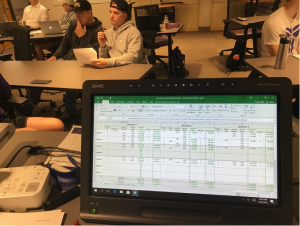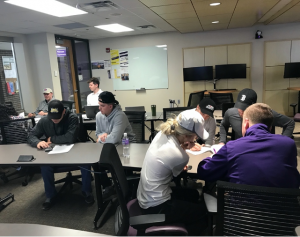23 An Investor-Entrepreneur Simulation Game for Business Students
Yilin (Leon) Chen
Introduction
The game that I have developed for the classroom is an investor-entrepreneur game that involves making investing or financing decisions through negotiations. The game illustrates and reinforces the concepts and calculations involving debt, equity, risk, and returns. It is designed for the 300-level business finance course, which is the common core course for all business majors.
The game requires the class to be separated into investor groups and entrepreneur groups. Each group has two students. The investor groups represent investment managers with a specialization in the energy sector from a venture capital firm, while the entrepreneur groups represent those who have an opportunity to develop an oil field in a large region that is recently discovered to contain oil. Entrepreneurs are already invested in a piece of land but need to seek investment to finance a rig. There is a chance of success with probabilities specified in each round of this game, and the business will be valued differently at the end depending on whether it is a success or a failure. The game is played in multiple rounds, and when investors and entrepreneurs negotiate a deal in each round, they can use either equity or debt. The risk and return profiles will certainly be different between debt and equity, and their goals are to maximize the expected payoff in all rounds through calculations and negotiations. Actual profits will also be revealed at the end of each round through the instructor’s announcement of success or failure for each deal.
The handouts of the game are attached in the Appendix. I played this game in my 400-level “financial institutions and markets” class this semester in April 2019, before formally trying it in business finance classes. It was a fun experience for both students and me, and overall, the results and efficiency of the game surpassed my expectations.
Game and course outcomes
The game learning outcomes are:
- Be able to distinguish the risk and return (payoff) scenarios between debt and equity
- Be able to calculate the expected payoff of debt and equity, given the chance of success
- Be able to make decisions on using either debt or equity, given the chance of success and the chance information asymmetry between investors and entrepreneurs
- Be able to negotiate financing deals
These outcomes are also the application-level or high-level learning outcomes for the business finance course, with (3) and (4) being optional course outcomes. I believe they also relate to some other 400-level finance course outcomes as well, such as the financial institutions and markets course. The 400-level courses go in-depth on topics such as valuation, private equity, and financial markets.
Evaluation of student learning
The games are played in multiple rounds of deal negotiations. In each round, each entrepreneur group is assigned a different chance (probability) of success, so students need to calculate the risk and return scenarios in that round. Each round lasts for about 8-10 minutes, and at the end of each round, the deals are reported to and recorded by me (the instructor). A snapshot of the recorded transactions is presented below. This information is updated continuously when the game is being played, and the spreadsheet contains the formula to automatically calculate the expected and actual profit for each group. It is displayed to the students throughout the game, and it serves the purpose of comparing results of different student groups, and students are also able to compare their numbers with the one on the screen to see whether they have done their calculations correctly.
At the end of the game, winning groups are rewarded with extra bonus points.The winning groups are defined as the groups with higher final accumulated expected payoff or actual payoff than the average. Also, student learning is evaluated through exam questions. In my third exam this semester, I have the following three multiple questions (with correct answers highlighted in yellow):
=====================================================
- In the Entrepreneur-Investor game we played in the classroom, we have the following information. An entrepreneur has already invested in land that is worth $100,000. She has no additional funding and needs to seek investment to finance a rig that costs $100,000. The chance of success of a potential oil field is 50%, in which case the oil field will be worth $480,000. If the business fails, the entrepreneur can sell the land and all equipment for a total price of $120,000. Assume that this is a 1-year investment. What is the game goal for both entrepreneurs and investors in this game?
- A) To maximize profits for both investors and entrepreneurs.
- B) To minimize the risk for both investors and entrepreneurs.
- C) To maximize the expected profits for the investor and to minimize the interest payment for the entrepreneur.
- D) To minimize the expected loss for the investor, and to maximize the profits for the entrepreneur.
- Following the previous question about the classroom game we played, if an investor invests $100,000 in exchange for 40% of the equity, what is the expected payoff of that investor?
- A) $100,000
- B) $120,000
- C) $150,000
- D) $180,000
- Following Question 48, which of the following did we observe when more rounds of the game were played?
- A) The actual total profit gets closer to the expected total profit for each group on average.
- B) The expected total profit decreases for each group on average, due to the risk-taking.
- C) Entrepreneurs are more likely to use equity if the chance of success is high.
- D) All of the above.
=====================================================
Game experience and summary
The game played in my class this April was a great experience for both my students and me. It was played in six rounds in total, and it went very smoothly, which surpassed my expectation. The class runs for 75 minutes, and I spent the first 10-15 minutes explaining the game rules and assigning student groups. Then each round was played for 8-10 minutes. Then I spent the last 5 minutes of the class making concluding remarks. Students were very engaged throughout the game, and two students told me after class that it was something they liked and they learned a lot. Below are two pictures I took during the class to show their process of calculation and negotiating deals, and checking their answers with my version (the one shown on the screen).

Figure 22. Teacher version of the investor spreadsheet

Figure 23. Students playing the Investor-Entrepreneur Simulation
Appendix I: Handout to investor groups from Investor-Entrepreneur Simulation
Appendix II: Handout to entrepreneur groups for Investor-Entrepreneur Simulation

